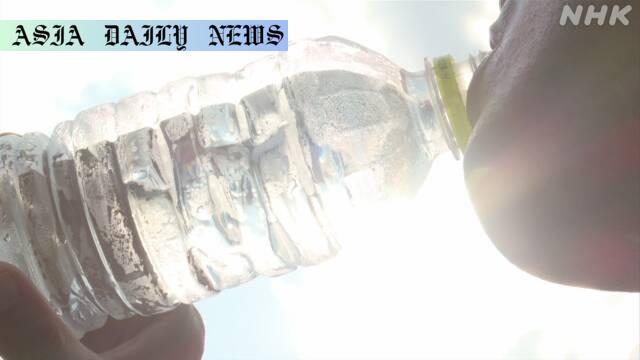Heatwave: Dangerous heatwave grips Japan with record-breaking temperatures surpassing 40°C, affecting vast regions and issuing alerts.
Dangerous heatwave hits Japan with temperatures over 40°C.
35 prefectures under heatstroke alerts across the country.
Weather officials advise precautions like hydration and rest.

Japan is currently enduring a dangerous and relentless heatwave as temperatures soar past 40 degrees Celsius for the third consecutive day, affecting extensive areas and driving widespread concern. On Friday, Kuwana City in Mie Prefecture registered blistering temperatures of 40.4°C. These rising temperatures followed a record-breaking high of 41.2°C observed in Tamba City, Hyogo Prefecture, on Wednesday, marking some of the hottest days in Japan’s recorded history. The scorching weather is expected to continue into Saturday, striking regions from Kanto to Kyushu.
Regions Affected and Temperature Forecasts
Saturday’s forecasts show daytime highs of around 39°C in areas like Kumagaya City (Saitama Prefecture), Nagoya, Gifu, Okayama, and Hita in Oita Prefecture. Meanwhile, many cities, including Maebashi, Kyoto, Saitama, and Hamamatsu, anticipate temperatures of 38°C. In Osaka, Hiroshima, and Nara, highs of 37°C are expected, while Tokyo and Kobe will likely see temperatures rise to 36°C. Taken collectively, these conditions highlight the vast scope of the heatwave, cutting across regions that include both northern and southern Japan.
Heatstroke Alerts and Precautionary Measures
Concerns over public safety have prompted the Japan Meteorological Agency (JMA) to issue heatstroke alerts across 35 of the country’s 47 prefectures. Regions ranging from Okinawa in the south to Tohoku in the north are advised to adopt strict preventive measures, such as frequent hydration, the use of air conditioners, and avoiding prolonged outdoor activities. Authorities further encourage consumption of salt to maintain electrolyte balance and provide reminders for individuals to take regular breaks, particularly those engaged in outdoor work or strenuous activities.
Health Implications and Preparedness
This prolonged heatwave raises serious health concerns, especially among vulnerable populations such as the elderly, children, and individuals with existing health conditions. Heatstroke, dehydration, and other heat-related illnesses pose immediate risks, necessitating proactive steps to minimize potential casualties. Municipal authorities are expanding public cooling shelters, setting up hydration stations and disseminating health-awareness campaigns to ensure widespread understanding of the necessary precautions. By adopting these measures, communities hope to reduce the adverse effects of what has become one of the most extreme weather events this summer.
Global Context and Long-Term Solutions
The sweltering conditions in Japan contribute to a broader global pattern of extreme weather events, many of which are tied to climate change. Prolonged heatwaves, dwindling freshwater resources, and shifting weather patterns emphasize the importance of global collaboration. Sustainable urban planning and investment in green infrastructure, such as urban forests and heat-absorbing materials, are among the solutions gaining traction. Targeted strategies aimed at achieving resilience within urban centers could mitigate danger during extreme conditions.
With persistent challenges posed by climate-induced events, this relentless heatwave serves as a stark reminder: urgent measures are critical in addressing environmental instability. Japan’s ongoing ordeal underscores the necessity for nations and global communities to invest in adaptive solutions while fostering a sense of collective environmental responsibility.



Commentary
The Immediate Threat of Extreme Heat
This ongoing heatwave gripping Japan is a stark reminder of the fragile balance humans share with nature. Temperatures exceeding 40°C are not just numbers but signify genuine threats to daily life, health, and infrastructure. The affected areas span from rural regions to bustling cities, emphasizing how no one is entirely insulated from the dangers posed by climatic extremes. The rapid issuance of heatstroke alerts highlights the urgency with which authorities are approaching this problem. However, their success depends as much on public vigilance as institutional preparedness.
Health Challenges Amplified During Prolonged Heatwaves
The health risks during such high-temperature events cannot be understated. Vulnerable groups, including the elderly and children, face heightened risks of dehydration and heatstroke, especially when cooling systems are unavailable. Public messaging to stay hydrated, take cooling breaks, and consume electrolytes has been exceptional, though significant gaps still exist in how communities manage rising health emergencies. While municipal governments have set up cooling shelters, access can sometimes be uneven for rural or underprivileged populations.
Broader Implications and the Global Climate Crisis
The frequency and intensity of heatwaves across the globe have drawn scientists to attribute these developments to the ongoing climate crisis. The alarming temperatures recorded in Japan reflect a broader narrative of climate instability. Long-term efforts in climate mitigation, including reductions in greenhouse gas emissions and pushing for renewable energy practices, remain pivotal. Countries, including Japan, must look toward adaptive strategies to promote urban resilience, such as greener spaces or heat-resistant planning within cities.
Ultimately, the unrelenting nature of this heatwave carries lessons not just for Japan but for the global community. Every disaster, even if local, serves as a universal reminder of our shared responsibility toward environmental stewardship. Collaboration, innovation, and proactive decision-making can help societies transition toward more sustainable practices while safeguarding vulnerable populations from emerging environmental threats. This wave of dangerous heat must ignite commitments for a greener, safer tomorrow.